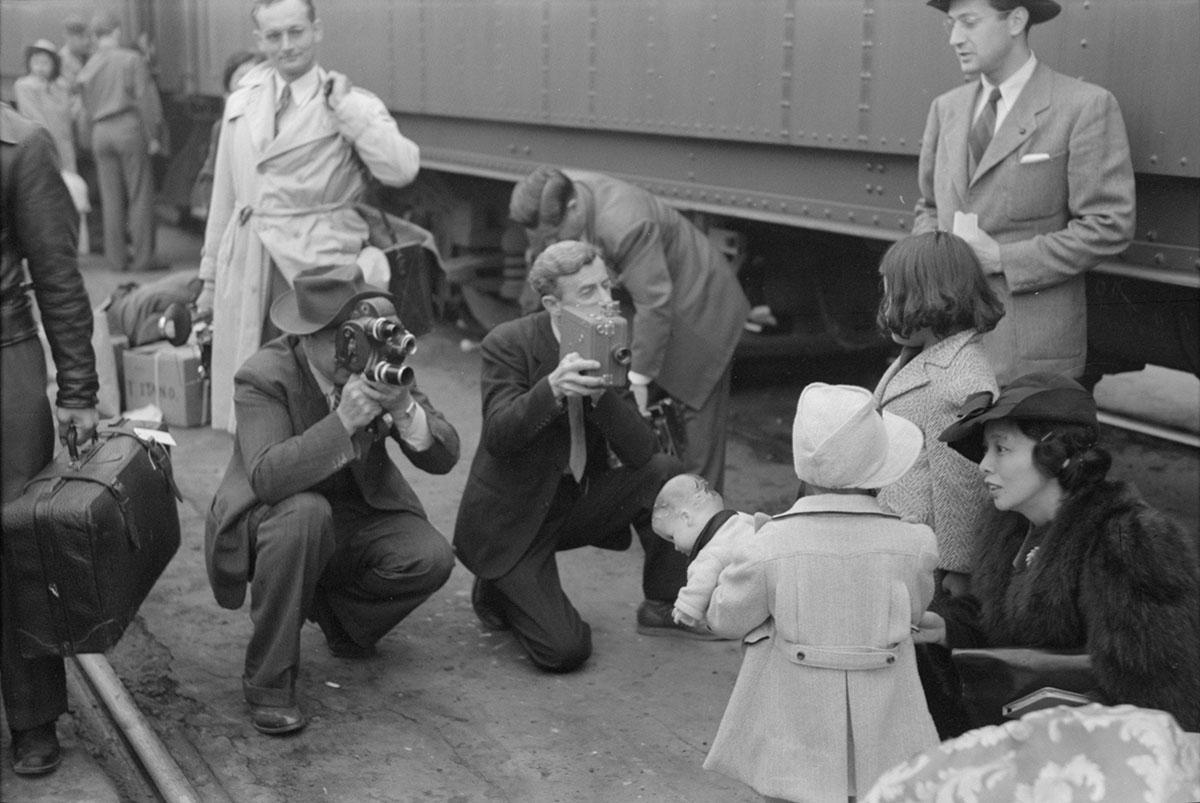The photographs on this wall are the full-frame versions of the closeups you saw in the previous room. These, and the rest of the photos in this room, were taken by Dorothea Lange. The War Relocation Authority, or WRA, hired Lange to photograph the Japanese American incarceration. However, they imposed restrictions on her work as a photographer: “no talking with incarcerees,” “no pictures of barbed wire fences, watch towers or armed guards.” Nevertheless, upon viewing Lange’s photographs, the WRA impounded them for the duration of the war. Though these photos have been in the National Archives since then, they were not brought to public attention until 1972, and again in 2006 when they were published in books. As you observe Lange’s photographs, consider how, or whether, Lange is able to capture the reality of the situation given the restrictions imposed on her.
To your left, there are five photographs of Japanese Americans lining up outside the Japanese American Citizens League building in San Francisco on April 25, 1942. This was in response to Exclusion Order 20. Copies of this order were posted all around the district.
[hammer sound effect]
There were 108 exclusion orders in total issued across the West Coast, each one directing Japanese Americans from a different region to report to their nearest civil control station. There, they would register and receive a family number in preparation for the forced removal. If they failed to show up, they faced fines and imprisonment.
“Please have a look at the far left picture, the lady calculating the length of the line. Her name is Shizuko Ina. You also can find her in the rightmost picture. Please observe carefully about the shadows between the leftmost and rightmost photos, we can estimate how much time they spent at the same location. This was also same duration with Dorothea Lange.”
Fujihata’s observations reveal that photographs are more than just flat two-dimensional representations of people and places. Rather, when put in conversation with one another, they can reveal clues about meaning and context, teaching us more about the subjects and their experiences.
The large photograph on the next wall tells another story from that same day.
[sound effect: child talking, woman laughing]
The woman sitting on the upper right of the stairs is Mrs. Nakamoto. She is pictured with her two children on either side of her and their friends.
Though seemingly an ordinary photograph, Fujihata once again sensed that there was more to it than what meets the eye.
“Throughout my research, I saw quite a few photographs with people smiling and I felt a bit uncomfortable with many of them. Most of them are directed by the cameraman therefore the smiles are superficial. However, among all these smiles, Mrs. Nakamoto’s smile is very different from others. I can say it is full of mercy and peace. So, I wanted to know the reason behind this special smile. I started checking Dorothea Lange’s itinerary when she went to where, especially in April 1942. After a few months of research, I finally found her memo at the Bancroft Library in UC Berkeley, which looked like a draft for the report to the War Relocation Office. The memo telling us: ‘April 25th we were doing the line outside the San Francisco Japanese American Citizens League waiting to be processed. Mrs. F. Nakamoto was the pregnant woman sitting on the steps with her children. She wanted a picture of the children to send to her husband who had been sent to North Dakota a couple of months ago.’”
Why was Mrs. Nakamoto’s husband sent to North Dakota? He, alongside countless other Issei men, many of them community leaders, had been arrested by the FBI in December of 1941—some just hours after the Pearl Harbor bombing. Labeled as dangerous enemy aliens, they were arrested without evidence and, without a trial, were sent to prisons run by the Department of Justice.
“Now we know this is a very private photograph, because her smile had been dedicated to her husband, not for us. Therefore, when we see this photograph, we have a responsibility to receive her smile because we are standing in her husband's position. At this point, we are already involved in the history of this photograph.”
The next six photos show scenes from the first forced removal in San Francisco.
[sound effect: people shouting, doors/trunks closing, car driving away]
On April 29,1942, Japanese Americans were boarded onto buses and sent to Tanforan Temporary Detention Center. If this place looks at all familiar to you, that’s because these photographs were taken on the same street where registration occurred—just four days prior. Four days—to pack what you can carry, sell the rest, and say goodbye to the life you’ve led up until that point.
“The second photo from the right shows a slightly different atmosphere. Within a mountain of luggage, there are several people waiting, but no one is smiling. Usually Lange took several photos with the same subjects within different distances. But in this case there is only one photograph was left, perhaps she could not continue the photo session. Their eyes are shouting to show their attitude and prevent her approach. They resisted to be taken a picture. I think this is quite a rare photograph capturing the honest reaction from the Japanese Americans.”


